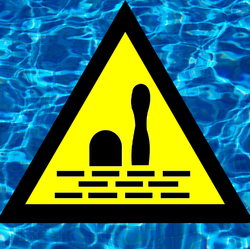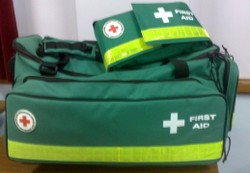I was getting about one in five.
The Reddit thread contained a number of lifeguard rescue videos depicting real world drowning. Even now knowing what I was looking for, I was still surprised by the whistle. Most of the time, I didn't know which person was drowning until the lifeguard reached them.
I witnessed a father standing just a few feet from his drowning son. His expression only turned to one of desperate horror, when the lifeguard stopped at his own child.
I saw a group of friends all grinning at their peer as he drowned. The whistle sounded. They looked around in curiosity to see who ailed. Then back in shock as the lifeguard towed their own friend to safety. Any one of them could have reached out and touched him in the seconds before the rescue.
It was a wake up call that the reality of drowning is nothing like you think it's going to be.

















 St Tydecho's Churches in West Waleson 09/03/2014
St Tydecho's Churches in West Waleson 09/03/2014
 Goodies for an Outlander Premiere Partyon 03/06/2015
Goodies for an Outlander Premiere Partyon 03/06/2015
 Holocaust Memorial Day Interview with Rainer Höss, Grandson of Rudolf Architect of Auschwitzon 01/24/2015
Holocaust Memorial Day Interview with Rainer Höss, Grandson of Rudolf Architect of Auschwitzon 01/24/2015
 Romantic Valentine Gifts for an Outlander Fanon 01/16/2015
Romantic Valentine Gifts for an Outlander Fanon 01/16/2015



Comments
This all scared the life out of me, because even with all of the information, I'm not 100% convinced I could recognize drowning still.
I was just sharing what I learned about this with my mom the other day, and it reminded me to send it to my SIL, especially because we're about to have a pool party tomorrow and Friday.
Telesto - That prop to give a drowning person to grab isn't something that would ever have occurred to me. Until I read the Reddit thread, then researched further to write this, I would have done it all wrong.
For a start, I wouldn't have recognized that someone was drowning, and if I did, I would have jumped straight in there, approached from the front and attempted to save them that way. Which means that I would have run a high risk of drowning too.
Liz - That was my aim. It shook me to the core when I read that Reddit thread and realised that I would miss someone drowning. While watching those videos - now in full knowledge of what drowning really looks like - most of the time I couldn't identify the person in distress until the lifeguard reached then.
I'm grateful to the Redditor who raised my awareness, and this is my way of passing that information on.
Good advice to give the person something to grab onto. I can't watch the videos where I am at the moment, and am rather pleased I can't.
What an important page. There are so many wrong ideas that people have about drowning. By this page you will almost certainly have saved some lives.
Me too now. Which is what scared me enough to write this article!
Good information on recognizing drowning. As for the Chinese boy, I have read many stories like that.
Ouch! Yes, that was choking. It looks like it was far enough down that swallowing worked better for you. Most people choking go through the coughing part first. She needed to smack you on the back.
Oh well I will say I'm not certain how typical my experience was, it most certainly wasn't a case of something getting lodged in my throat and blocking anything...and I'm still not sure exactly what happened. Had a rep in who wanted me to try their new cough drops/bring them into my store. So she had me try one, and she asked me to bite into it, because the center had honey and pine pollen. So she went on talking to me about other products. When I swallowed, apparently one piece was like a shard of glass and stabbed me and got stuck....somewhere in my throat. I still haven't figured out what happened, but if I had to guess it was stuck right between my esophagus and my wind pipe. I didn't cough at all. I felt it stab me and it caused more of a swallowing response, but I couldn't stop and I couldn't breathe between them either. Maybe it just belongs in the category of random, really unlucky, freak accident. I was perfectly calm too, apart from when I was like "ow" from being stabbed by candy shards. It was literally the size of a grain of rice or smaller. I reached a moment where I realized oh I'm chocking. And I wanted to cough but I wasn't breathing and couldn't so I couldn't cough. I have to tell you it is the weirdest feeling to need to cough and physically not be able to, I did almost throw up. I had a bottle of water on my desk right in front of me and I eventually attempted to drink some. That's when the rep noticed me, but at that point it was entirely obvious something was wrong, my eyes were watering badly, and I probably had a look on my face. After I drank some water I finally did start coughing, which eventually did dislodge the tiny evil piece of candy, and also made me throw up XD Today my throat feels like I swallowed glass.